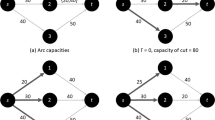Abstract
Each are (i, j) of the network has capacity ξ ij where ξ ij is a non-negative random variable. The capacity of any arc may be reduced increased by an amountu ij ≥0 at a cost ofc ij u ij . The objective is to maximizev−K∑c ij u ij wherev is the expected maximum flow. This problem is formulated as a two-stage linear program under uncertainty. Each feasible\(\bar u = ||\bar u_{ij} ||\) generates a constraint\( - \Sigma \pi _{ij} (\bar u)u_{ij} + \theta \leqslant \rho (\bar u)\) where\(\pi _{ij} (\bar u)\) is the probability arc (i, j) is in the minimum cut set and\(\rho (\bar u)\) the expected value of the maximum flow under\(u = (\bar u)\). The formulation is later generalized to include certain conditions under which the increase in capacity of an arc may be a non-deterministic function of the investmentc ij u ij .
Similar content being viewed by others
References
S. Arunkumar and S.H. Lee, Optimal improvement in probabilistic networks to maximize the expected flow capacity: continuous random arc capacities, Department of System Science, University of California, Los Angeles, California (1976).
S. Arunkumar, S.H. Lee and R.D. Wollmer, Optimal improvement of flow networks with continuous random arc capacities, unpublished report (1981).
J.F. Benders, Partitioning procedures for solving mixed-variables programming problems, Num. Math. 4 (1962) 238–252.
J. Birge and R.J.-B. Wets, Designing approximation schemes for stochastic optimization problems, in particular for stochastic programs with recourse, Math. Progr. 27 (1986) 54–102.
G. Bradley, G. Brown and G. Graves, Design and implementation of large-scale primal transshipment algorithms, Manag. Sci. 24 (1977) 1–35.
G.B. Dantzig and A. Madansky, On the solution of two-stage linear programs under uncertainty, in:Proc. 4th Berkeley Symp. on Mathematical Statistics and Probability, vol. 1 (University of California Press, Berkeley and Los Angeles, 1961) pp. 156–176.
G.B. Dantzig and D.R. Fulkerson, On the max-flow min-cut theorem of networks, in:Linear Inequalities and Related Systems, Annals of Mathematics Study 38 (Princeton University Press) pp. 215–221.
B.C. Eaves and W. Zangwill, Generalized cutting plane algorithms, SIAM J. Control 9 (1971) 529–542.
J.R. Evans, Maximum flow in probabilistic graphs — the discrete case, Networks 6 (1976) 161–183.
G.S. Fishman, Digital computer simulation: estimating sample size, The RAND Corporation, RM-5866-PR (August 1969).
L.R. Ford Jr. and D.R. Fulkerson, Maximal flow through a network. Can. J. Math. 8 (1956) 399–404.
L.R. Ford and D.R. Fulkerson,Flows in Networks (Princeton University Press, Princeton, NJ, 1962).
D.R. Fulkierson, An out-of-kilter method for minimal cost flow problems, J. Soc. Ind. Appl. Math. 9 (1961) 18–27.
F. Glover, D. Karney, D. Klingman and R. Russell, The simplex son algorithm for LP/embedded network problems, Transport. Sci. 12 (1978).
F.S. Hillier and G.J. Lieberman,Introduction to Operations Research (Holden-Day, San Francisco, CA, 1980).
P.A. Jensen and J.W. Barnes,Network Flow Programming (Wiley, New York, 1980).
J.L. Kelley Jr., The cutting-plane method for solving convex programs, SIAM J. Appl. Math. 8 (1960) 703–712.
K.G. Murty, Two stage linear programming under uncertainty: a basic property of the optimal solution, Z. Wahrscheinlichkeitstheorie und Verwandte Gebiete 10 (1968) 284–288.
V. Srinivasin and G. Thompson, Accelerated algorithms for labeling and relabeling of trees with applications for distribution problems, J. ACM 19 (1972), 712–726.
D.M. Topkis, Cutting-plane methods without nested constraint sets, Oper. Res. 18 (1970) 404–413.
R.M. Van Slyke and R.J.-B. Wets, L-shaped linear programs with application to optimal control and stochastic programming, SIAM J. Appl. Math. 17 (1969) 638–663.
D.W. Walkup and R.J.-B. Wets, Stochastic programs with recourse. SIAM J. Appl. Math. 15 (1967) 1299–1314.
S.W. Wallace, Investing in arcs in a network to maximize the expected max flow, Networks 17 (1987) 87–103.
R.J.-B. Wets, Programming under uncertainty: the equivalent convex program, SIAM J. Appl. Math. 14 (1966) 316–339.
R.D. Wollmer, Programming under uncertainty: variable dependent stochastic elements. TM 393-56, Jet Propulsion Laboratory, Pasadena, California (July 1970).
R.D. Wollmer, Investment in stochastic maximal flow networks, Technical Memorandum 393-66, Jet Propulsion Laboratory (August 1971).
Author information
Authors and Affiliations
Rights and permissions
About this article
Cite this article
Wollmer, R.D. Investments in stochastic maximum flow networks. Ann Oper Res 31, 457–467 (1991). https://doi.org/10.1007/BF02204863
Issue Date:
DOI: https://doi.org/10.1007/BF02204863



